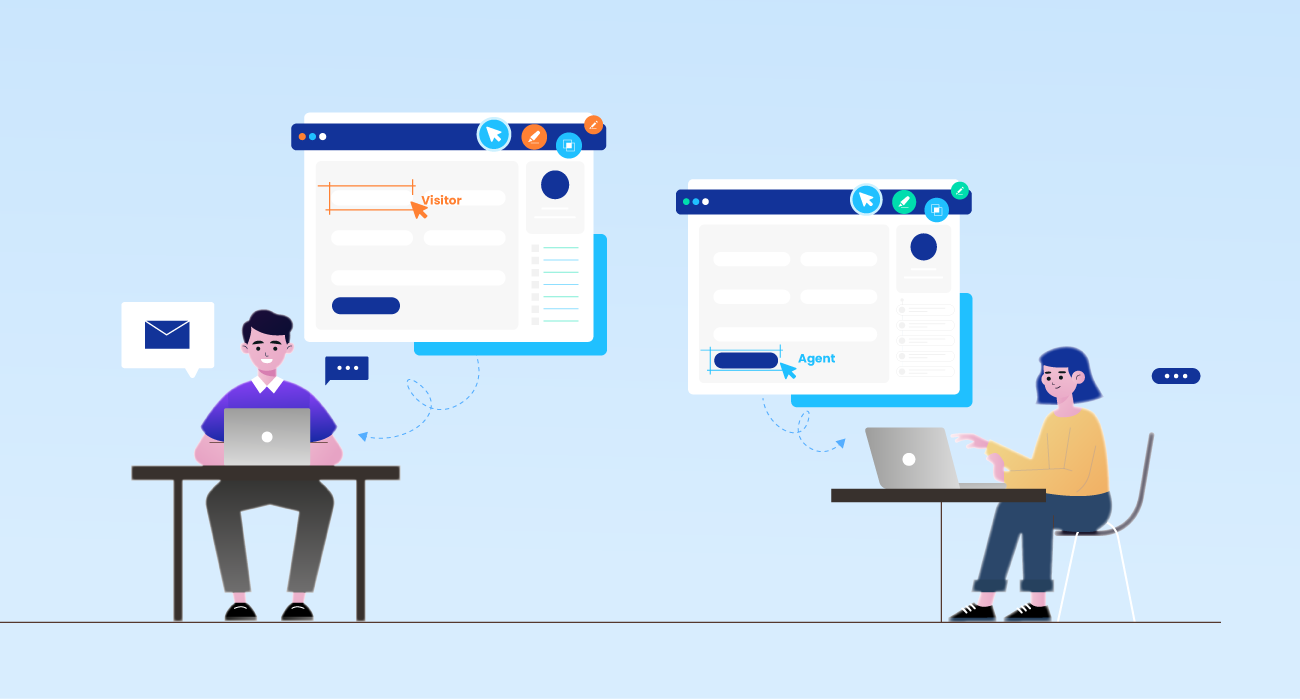Hello!
 Customer support agents may work with the customer’s browser in real-time via co-browsing, also known as collaborative browsing.
Customer support agents may work with the customer’s browser in real-time via co-browsing, also known as collaborative browsing.
The agent may examine the problem and collaborate with the customer to navigate over the customer’s screen and provide interactive customer support or sales help.
Businesses that prioritize client involvement are more likely to create value and increase their return on investment. With interactive and real-time help, they provide customers with a meaningful end-to-end customer experience.
How Does It Work?
 Modern co-browsing solutions use WebRTC (Web Real-Time) technology, which does not require any downloads, installations, or plugins. Peer-to-peer connections between two browsers are made possible by this browser-based technology, resulting in a fluid user experience with real-time contextual interaction.
Modern co-browsing solutions use WebRTC (Web Real-Time) technology, which does not require any downloads, installations, or plugins. Peer-to-peer connections between two browsers are made possible by this browser-based technology, resulting in a fluid user experience with real-time contextual interaction.
- The agent sees an exact visual picture of the customer’s browser screen when the co-browsing session begins.
- By safely navigating the website along with the consumer, the support personnel may help the customer.
- Agents may also annotate a customer’s view of a website, assist with form completion, and even documents overlay.
- WebRTC-based surfing also protects chats against malware and threats, and it is compatible with most modern devices and browsers, mobile browsers included.
Practical Co-browsing Examples
-
Mobile App and co-browsing
One example of co-browsing involves CSPs that want to boost the use of their self-service applications. Adoption, on the other hand, has been slow (estimated as below 30 percent). Their frontline agents might utilize a co-browsing solution to access the app on the customer’s screen and teach them how to use it. This would successfully aid adoption while also offering a great user experience.
-
Visual Assistance and co-browsing
 Consider the following example of co-browsing. A consumer calls to express his dissatisfaction with his internet speed. The agent provides a connection to the customer’s smartphone camera, allowing the agent to examine the router firsthand. As a result, he may lead the client to a solution.
Consider the following example of co-browsing. A consumer calls to express his dissatisfaction with his internet speed. The agent provides a connection to the customer’s smartphone camera, allowing the agent to examine the router firsthand. As a result, he may lead the client to a solution.
After the problem has been repaired, the agent gives the client the option of upgrading his broadband plan and then uses co-browsing technology to guide the user through the self-upgrade procedure on the provider’s website.
Visual guiding combined with co-browsing for live help allows for complete visual assistance, particularly when technology allows for a smooth transition between the two.
-
AI and co-browsing
A consumer, for example, calls in with a query about her latest bill. The chatbot collects basic information about the consumer and her wants before directing her to a real representative. The agent takes up the conversation and utilizes co-browsing to examine the customer’s bill in her browser. There are no more questions that need to be asked. The representative swiftly directs her to the website’s billing breakdown page, where she may adjust her membership.
-
Field Services co-browsing
 A recently recruited technician is deployed to a job site to collect measures and evaluate the property in this co-browsing scenario. His supervisor may access the company’s web-based field services workflow management program via co-browsing. They can see the steps that need to be taken to identify the issue and discover a solution together.
A recently recruited technician is deployed to a job site to collect measures and evaluate the property in this co-browsing scenario. His supervisor may access the company’s web-based field services workflow management program via co-browsing. They can see the steps that need to be taken to identify the issue and discover a solution together.
Customer-to-customer co-browsing
-
Customer-to-Customer co-browsing
For example, a consumer could ask a query about using the website to activate his SIM card or about an error message he gets on his web-based app. A forum user may use co-browsing to watch the user’s browser and guide him through the resolution procedure.
What Is The Difference Between Co-browsing Software And Screen Sharing Websites?
In the context of not being able to watch or control the customer’s screen, a co-browsing solution differs from screen sharing website. Unlike screen sharing, co-browsing allows your support employees to assist clients on their online journey by guiding them through the process of filling out a form or performing a specific action without having to download anything. For both agents and consumers, this makes contextual interaction safer and speedier.
The following are some of the features of co-browsing:
- It’s entirely browser-based. There are no further downloads or installs required.
- You may advise consumers as well as perform essential actions on their behalf via co-browsing.
- Co-browsing provides a collection of highlighter tools to aid clients in a more efficient manner.
- It is very safe since it is fully browser-based.
Also read:
- New Study Claims That Antidepressants Don't Lead to Better Quality of Life
- E-Commerce as a Means for International Growth
- Give Your Gym the Best Chance for Success
Conclusion
Customer service has unquestionably become a major differentiator for companies. Businesses that enhance their online consumer experience from ordinary to amazing will succeed in their sectors.
Adopting customer-centric strategies will surely provide a positive return on investment and establish a solid basis for your company. Co-browsing is a vital tool for giving your clients “that one-of-a-kind experience.” Combining co-browsing with live chat and video chat may leave a lasting impact.
Thank you!
Join us on social media!
See you!






